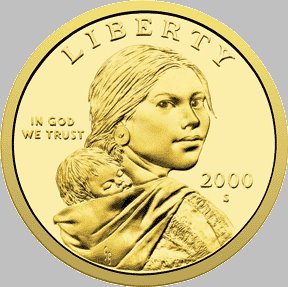'Madonna of the Expedition'

When Sacagewea was about 11, a band of Minataree warriors attacked her Shoshone encampment near the Missouri River in Montana and kidnapped her. Eventually, she was "purchased" by Toussaint Charbonneau, a French-Canadian trapper, who "married" her.
In 1804, at the mouth of the Knife River in North Dakota, Charbonneau was hired by Meriwether Lewis and William Clark to be an interpreter of Native American languages for the duration of their expedition across North America, but they specified that he bring along Sacagewea (whom Clark nicknamed "Janey") and her newborn child Baptiste (nicknamed "Pomp" by Clark), because Sacagewea was the only person available who understood Shoshone.
While Charbonneau proved himself to be something of a boorish lout, being reprimanded at least once by Captain Clark for hitting his young wife, Sacagewea proved useful in a number of ways: she became a badge of goodwill to the tribes the expedition encountered, since a war party would not have traveled with a woman; she helped identify edible plants for the expedition; and on one occasion during a freak storm she saved a store of supplies from being swept down the Yellowstone River while Charbonneau flailed and panicked. While she was helpful to the expedition with her knowledge of western Montana, she was not Lewis and Clark's principal guide, as schoolchildren are often misled; this claim was fabricated by Eva Emera Dye in her historical novel The Conquest (1902), who called Sacagewea the "Madonna of the Expedition," and has endured as a pleasant fiction ever since.
In November 1805, the expedition reached the Pacific Ocean. Sacagewea, Pomp and Charbonneau left the expedition upon its return to North Dakota in August 1806. Captain Clark noted in his diary that Charbonneau was a "man of no peculiar merit" but that his wife "was particularly useful," offering that "she has borne with a patience truly admirable the fatigues of so long a route encumbered with the charge of an infant." Clark paid Charbonneau $500.33, but paid no wages to Sacagewea.
Most scholars claim that Sacagewea died of "putrid fever" on December 22, 1812 at the age of 25, based on a subsequent entry in Captain Clark's journal and the fact that Clark appears to have adopted Pomp and Sacagewea's younger daughter Lisette shortly thereafter. Another, less accepted view is that the diary entry may have referred to Charbonneau's other Indian wife, Otter Woman. This view holds that Sacagewea survived into her 90s, leaving Charbonneau after he gave her a particularly cruel beating, marrying again and wandering throughout the West from reservation to reservation, staying for a time with the Ute wife of frontiersman Jim Bridger. Whoever that second woman was, she died on this date in 1884 at Fort Washakie, Wyoming at the age of about 96.
Labels: Exploration, Native American History, Trailblazing Women





1 Comments:
It should also be note that Sacagewea was no shrinking rose bud when it came to getting her way. While winter camped near the ocean in what is now Washington State, a whale washed up on the beach. Clark organized a patrol to go see for themselves and left Sacagewea off the list. She then reminded Clark of all she had done including saving the supplies from the river. She wanted to go and see the "big fish." Clark relented.
Post a Comment
Subscribe to Post Comments [Atom]
<< Home